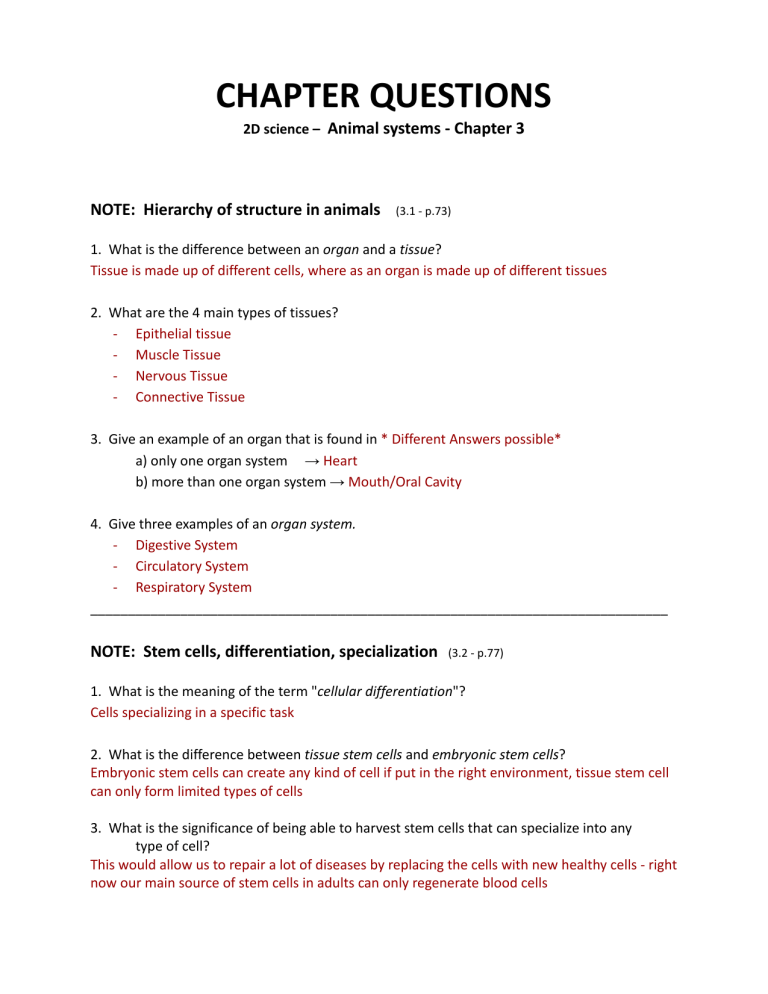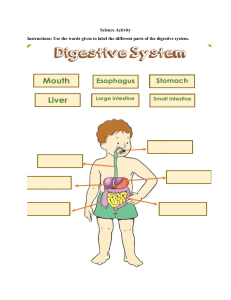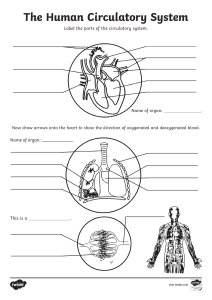Animal Systems Worksheet: Tissues, Stem Cells, and Organ Systems
advertisement

CHAPTER QUESTIONS 2D science – Animal systems - Chapter 3 NOTE: Hierarchy of structure in animals (3.1 - p.73) 1. What is the difference between an organ and a tissue? Tissue is made up of different cells, where as an organ is made up of different tissues 2. What are the 4 main types of tissues? - Epithelial tissue - Muscle Tissue - Nervous Tissue - Connective Tissue 3. Give an example of an organ that is found in * Different Answers possible* a) only one organ system → Heart b) more than one organ system → Mouth/Oral Cavity 4. Give three examples of an organ system. - Digestive System - Circulatory System - Respiratory System _____________________________________________________________________________ NOTE: Stem cells, differentiation, specialization (3.2 - p.77) 1. What is the meaning of the term "cellular differentiation"? Cells specializing in a specific task 2. What is the difference between tissue stem cells and embryonic stem cells? Embryonic stem cells can create any kind of cell if put in the right environment, tissue stem cell can only form limited types of cells 3. What is the significance of being able to harvest stem cells that can specialize into any type of cell? This would allow us to repair a lot of diseases by replacing the cells with new healthy cells - right now our main source of stem cells in adults can only regenerate blood cells 4. How is regeneration beneficial to an animal? Protection - ex. some animals will drop their tail if captured and regrow it later 5. Why do some people freeze umbilical cords? Source of stem cells in case of medical issues that require stem cells later on in life - would have the same DNA as the child 6. Do all tissues in humans regenerate? Explain. No, most cells can regenerate to a degree (ex. hair, skin, liver), but some cells are not able to regenerate and repair once they are damaged (nerve cells) ______________________________________________________________________________ NOTE: Digestive system (3.3A - p.80) 1. Why is it necessary for food to be digested? Digestion is the process of breaking food down into smaller pieces or changing the composition of the compounds inside. If we did not digest food, we would not be able to absorb the nutrients inside of it. 2. What are the two main methods/types of digestion? Explain how each type differs from the other and state the location in the digestive tract where these processes/types occur. Chemical digestion - mouth and stomach - changes the composition of compounds in food via chemical reactions Mechanical digestion - mouth, stomach - physically breaking food into smaller pieces to increase their surface area 3. Why do you think that it's important that the digestive system is lined with muscle? This allows movement of material via contraction of muscle tissue ______________________________________________________________________________ NOTE: Digestive system organs (3.3B - p.81) 1. Name two functions of saliva. - Lubricates food, breaks down starches 2. Why is it important to have an epiglottis? - stops food going into the windpipe 3. Explain how peristalsis works. * did not discuss - this is how the esophagus pushes food down via two types of muscle contraction* 4. Name two functions of the stomach. Food storage - holds food to release throughout the day Digests food - mechanically and chemically 5. Why is the length of the small intestine significant? Allows for better absorption of nutrients due to the surface area inside the tube 6. Contrast the functions of the small and large intestines. Small intestine absorbs mainly nutrients Large intestine absorbs mainly water NOTE: Digestive system accessory organs (3.3C - p.82) 1. Explain the function of the liver and the gallbladder. Liver produces bile and filters out blood, gall bladder stores and concentrates bile for later use in the stomach 2. Why is bile needed in digestion? Bile is used to digest fats 3. Other than helping with digestion, what other functions does the liver have? Filters toxins from the blood 4. Name two functions of the pancreas. Secretes digestive enzymes Regulates blood sugar via insulin 5. What is the difference between type 1 and type 2 diabetes? Type 1 - pancreas does not produce insulin Type 2 - cells less sensitive to insulin 6. What does insulin and glucagon do? Insulin lowers blood sugar, glucagon raises blood sugar ______________________________________________________________________________ NOTE: Circulatory system + blood (3.4A - p.83) 1. What is meant by the term "homeostasis"? The bodies ability to maintain it’s internal environment (example: maintaining temperature, hunger cues, etc). 2. What are the functions of red blood cells, white blood cells, and platelets? RBC - bind to gases for transport. WBC - Immune response Platelets - Blood clotting 3. What does hemoglobin do specifically? Binds oxygen and carbon dioxide 4. What is blood plasma? Carrier fluid - 90% water 5. What are some of the functions of the circulatory system? - Transport of gases - Thermoregulation - transport of nutrients 6. Explain how the circulatory system interacts with the digestive system. Nutrients from the digestive system are absorbed into the blood stream via the intestines and the circulagtory systems transports those nutrients via blood inside of blood vessels 7. Name at least four substances that are carried by the circulatory system. - Oxygen - Nutrients - Hormones - Waste - ie. carbon dioxide _____________________________________________________________________________ NOTE: Structure/function of heart & blood vessels (3.4B - p.84) 1. Why is the heart considered to be a "double pump"? Right side acts as pump to the lungs, left side acts as pump to the body 2. Where does blood pumped out of the right side of the heart go? What is the name of this vessel that this blood leaves through? Lungs via the Pulmonary Artery 3. Where does blood pumped out of the left side of the heart go? What is the name of this vessel that this blood leaves through? Body via the pulmonary vein 4. Name two differences between an artery and a vein. Artery carries blood away from the heart (delivers blood) veins carry blood towards tghe heart (recieves blood) 5. What do capillaries do? Small blood vessels (1 cell thick) that cause blood to slow down and increase surface area at the site of gas exchange to allow proper diffusion of substances (ie. convery belt analogy) 6. What type of blood vessel are you feeling when you are taking your pulse? Explain. Artery, thicker and more muscular - closer to the heart so you can feel the “pump” of pressure as the heart pumps blood into the arteries 7. Explain the path that a blood cell would take when it first enters the heart, all the way to where the blood cell leaves the heart on the way to the body. Mention all the names of the atria and ventricles that it has to pass through, in order. Blood enters the right atria from the vena cavas and flows past the tricuspid valve into the right ventricle. The right ventricle pumps blood through the pulmonary valve into the pulmonary artery towards the lungs where the blood becomes oxygenated again. The newly oxygenated blood flows back into the left atria via the pulmonary vein, it then flows past the mitral valve into the left ventricle. The left ventricle them pumps the blood passed the aortic valve into the aorta to be delivered to the body. 8. What are the names of the 4 heart valves. Where are they located? Pulmonary valve - controls blood flow between the right atria and right ventricle Pulmonary valve - controls blood flow between the right ventricle and the pulmonary artery mitral valve - controls blood flow between the left atria and left ventricle Aortic valve - controls blood flow between the left ventricle and aorta 9. What does an ECG do? Measures electrical pulses that chart how the heart beats to aid in diagnosis of heart conditions 10. Which artery is the only artery that doesn't contain oxygenated blood? Pulmonary artery - carries deoxygenated blood from the heart to lungs to be oxygenated - still an artery because it carries blood AWAY from heart NOTE: Circulation (disease) (3.4C - p.85) 1. What are plaques and how are they caused? fatty deposits inside a blood vessel - can be caused by poor diet, smoking, genetics 2. What is meant by the term "heart attack"? Blood clot that blocks blood flow to the heart causing it to not get oxygen and stop beating ______________________________________________________________________________ NOTE: Respiratory system (3.6A - p.91) 1. What are alveoli? Explain how gases are exchanged in these structures. What natural process is essential for all of this to happen? Alveoli are air sacs at the end of bronchioles int he lungs. These have a very thin membrane that allows for oxygen to diffuse into the blood stream, and carbon dioxide to diffuse out of the blood stream into the lungs to exit the body on an exhale. Diffusion is the natural process where particles move from an area of high concentration to an area of low concentration 2. Why is breathing through the nose better in some situations? more protective measures agoung debris and bacteria, better temperature control of breath 3. Contrast the function of the esophagus and the trachea. Esophogas carries food to the stomach, where as the trachea carries air to the lungs 4. Why does the trachea contain cartilage rings along the tube? To help maintain it’s structure and prevent collapse so you can continuously breath 5. What is the difference between a bronchus and a bronchiole? Bronchus - one of the main branches off of the trachea, bronchiole - a smaller branch off of either bronchus (bronchus is singular, bronchi is plural) 6. Explain what the diaphragm does to help us breathe (inhalation and exhalation). In between breaths, the diaphragm is a relaxed muscle that pushes up on your lungs. Upon inhaling, the diaphragm will contract causing the chest cavity to expand and pull air in. Upon exhaling, the diaphragm relaxes and pushes up causing the chest cavity to deflate and push air out. 7. How does an animal's respiratory system depend on its circulatory system? Circulatory system is required to pump the oxygen brought in by the respiratory system. 8. Explain the difference between breathing and gas exchange. Breathing is the process of bringing in oxygenated rich air and pushes out carbon dioxide rich air. Gas exchange is the process of oxygen and carbon dioxide diffusing across a membrane ___________________________________________ **Didn’t cover the other topics - you can look up if you want but will not need to know for test** ___________________________________ NOTE: Respiratory disorders (3.6B - p.94) 1. What does a bronchodilator do? 2. What is bronchitis? 3. What problems do people with CF have? ______________________________________________________________________________ NOTE: Organ transplantation (3.7 - p.96) 1. What is one of the biggest problems people can have once they have a transplant? Explain. 2. What is "xenotransplantation"? 3. Distinguish between living donor transplants and deceased donor transplants. Which type is more common? ______________________________________________________________________________ NOTE: Musculoskeletal system (3.8A - p.99) 1. What is the difference between a ligament and a tendon? 2. What are the three types of muscle? Give an example of each type of muscle. 3. Explain what must happen to the muscles in your arm to pick up an apple and bring it to your mouth. 4. What is osteoporosis and how can it be prevented and/or treated? 5. Bone fractures are more common among senior citizens than among young people. Propose an explanation. 6. What are the main functions of the musculoskeletal system? NOTE: Nervous system (3.10 - p.104) 1. What is the difference between the central nervous system and the peripheral nervous 2. 3. 4. 5. 6. system? What is the function of myelin on nerve cells? What is the function of the cerebrospinal fluid? Explain how a reflex works (in detail). What is a concussion? What medical technology can be used in the diagnosis of head injuries or injuries to the central nervous system? ______________________________________________________________________________ NOTE: Interactions of systems (3.11 - p.108) 1. Explain (in your own words): a) how the digestive system and circulatory system work together b) how the circulatory system and the musculoskeletal system work together c) how the respiratory system and the circulatory system work together d) how the nervous system interacts with other organ systems 2. Choose one more organ system interaction (that we have not discussed) and explain how these two organ systems work together.


